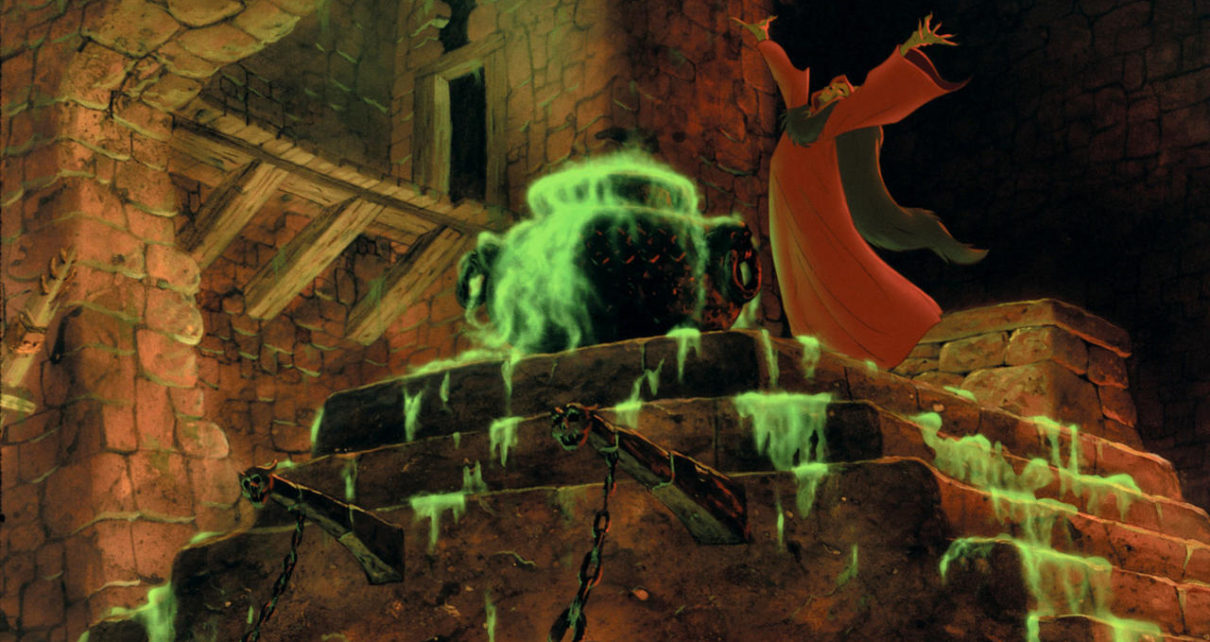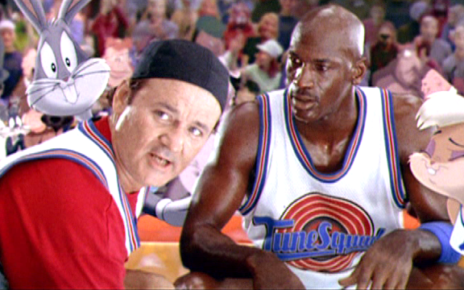Is It Still Good!? is a column measuring the continuing cultural strength of past animated products in the present. We use the mathematical formula (Force = Mass x Acceleration) as our model, where (Is It Still Good!? = Product x Decay Over Time, or, DOT). It is a proven model. Trust us. We’re the experts.
The Movie
The Black Cauldron (1985)
The Creators
Joe Hale (producer and writer); Ron Miller (producer); Ted Berman, Richard Rich (directors and writers); Vance Gerry, David Jonas, Roy Morita, Art Stevens, Al Wilson, Peter Young (writers); Lloyd Alexander (author of the Chronicles of Prydain book series, on which the movie is based)
The Logline
“A young boy and a bunch of misfit friends embark on a quest to find a dark magic item of ultimate power before a diabolical tyrant can.”
The Memory
During family visits to my aunt and uncle’s home, my brother and I would inevitably end up parked in front of the TV while the adults chatted in the dining room about important, adult matters. There were exactly four VHS tapes to choose from at their house: A Rugrats Passover (give it an Oscar), an obscure 1994 animated version of The Secret Garden (scary), a grainy recording of Riverdance (why?), and The Black Cauldron. I often joke that my parents didn’t expose me to the “normal” mid-90s Disney movies (Beauty and the Beast, Aladdin) when I was growing up, just the weird ones (The Hunchback of Notre Dame, Pocahontas II) and flicks from smaller, lesser-known studios. I suppose my aunt and uncle followed their lead.
The Context
In 1971, Walt Disney Productions optioned the Chronicles of Prydain, a children’s high fantasy series by Lloyd Alexander. Because of studio turmoil, creative differences, and a struggle to consolidate a pentology’s worth of story into an 80-minute movie, The Black Cauldron didn’t hit theaters until nearly fifteen years later, in 1985. The late 1960s through the late 1980s was a rough period for Disney, and this movie is often referred to as its “rock bottom.” The Black Cauldron was meant to revitalize the studio, which had been struggling since Walt Disney’s death amid a decline in popularity of animated musicals for children and internal restructuring. Instead, the film was a critical and commercial failure. The Disney Renaissance wouldn’t begin until a few years later, with films like The Little Mermaid and The Lion King.
The Product
The Black Cauldron follows assistant pig-keeper Taran on his journey to destroy the mythical black cauldron, an ancient relic with enormous power, before the Horned King can get his claws on it. Along the way, viewers meet a diverse cast of characters: Caer Dallben (Taran’s guardian), Hen Wen (an oracular pig), Gurgi (a Smeagol-like dog creature), Princess Eilonwy (who was animated in the style of Princess Aurora from Sleeping Beauty), bard Fflewddur Fflam (voiced by Nigel Hawthorne, who would later go on to voice Professor Porter in Tarzan), Creeper (the Horned King’s right-hand goblin), a group of indignant fairies (who live underground), witch-sisters Orddu, Orwen, and Orgoch (they always come in threes, don’t they?), and two wyverns. For a movie only 80 minutes long, The Black Cauldron packs in a lot of content, although not very successfully.
In a Scholastic interview, Lloyd Alexander asserts that “there is no resemblance between the movie and the book. Having said that, the movie in itself, purely as a movie, I found to be very enjoyable. I had fun watching it. What I would hope is that anyone who sees the movie would certainly enjoy it, but I’d also hope that they’d actually read the book.”
Like Alexander suggests, the movie itself is a bit of a hodge podge, both in tone and in plot. The Black Cauldron was meant to appeal to slightly older audiences. Unlike many Disney classics, it’s not a musical, and it was the first Disney animated movie to use computer-generated animation and also the first to receive a PG rating. However, certain scenes from the film were deemed too scary and violent for children, resulting in last-minute cuts that hurt the movie’s continuity. In his book Disney War, author James B. Stewart recounts Disney’s studio chairman at the time, Jeffrey Katzenberg, frantically hacking away at the film in the editing room after seeing the final version for the first time, much to the animators’ dismay: “Katzenberg managed to cut just a few minutes, and by his own admission, could only make it slightly less bad.” Most of The Black Cauldron team was fired after the film’s release. In short, the movie was a fiasco.
While most critics panned the adaptation—it’s currently at 55 percent on the Tomatometer—some deemed it a successful return to form for Disney animation. Roger Ebert writes, “The Black Cauldron is a rip-roaring tale of swords and sorcery, evil and revenge, magic and pluck and luck…. By the end of [the movie] I was remembering, with something of a shock of nostalgia, the strength and utter storytelling conviction of the early Disney animators.”
The Black Cauldron’s soundtrack, now hard to find, is regarded as one of the best works of master cinematic composer Elmer Bernstein, of The Magnificent Seven fame. Unfortunately, as a result of cuts to the movie, most of his compositions can’t actually be heard in the film itself.
Decay Over Time
Aside from my association of The Black Cauldron with my aunt and uncle’s house, my memories of the film are fuzzy. That VHS was well-used when I was growing up, but prior to a recent rewatch, I could only remember there being a pig, a terrifying villain, and a lot of lime green, that frequent harbinger of evil in Disney movies. I’m sure that as a kid, all the behind-the-scenes drama that led to the movie’s discontinuity and critical and commercial failure wasn’t obvious to me. As an adult, it is.
The Black Cauldron introduces viewers to new characters at a breakneck pace, the plot is flimsy at best, the last-minute cuts render the film disjointed and leave audiences feeling disoriented, and our hero Taran is… kind of a jerk.
Yet, as I was rewatching the movie as an adult, I was struck by how good it still looks. At one point, my roommate asked me when the film was made—its mix of traditional and computer animation makes it hard to place in time, and the neon oracular scenes pair well with backdrops painted in traditional Disney style, à la Snow White. The impact is magical.
The Black Cauldron is also still genuinely unsettling—I actually jumped once or twice. Disney villains are often a bit ridiculous (think of Ursula, Gaston, or even Scar), but John Hurt’s Horned King is pure horror. The depictions of violence in the movie, even with the aforementioned cuts of its most disturbing moments, surprised me. About fifteen minutes into the film, Taran loses track of Hen Wen, who is then chased down by the Horned King’s wyverns in a chilling scene. The pig squeals as the dragon-like creatures circle her, repeatedly picking her up, dragging her through the dirt, and then dropping her painfully on the ground. I’m not someone who does well with portrayals of violence against animals on screen, and I can imagine that children would find this scene particularly nightmare-inducing.
Under the shadow of coronavirus and after days of social distancing (what better time to rewatch old childhood favorites?), my roommate and I found the cult classic strangely apropos in its bleakness. The movie’s dark Mordor-esque landscapes, the Horned King’s army of undead Cauldron-Born zombies, and Bernstein’s eerie soundtrack succeed in creating an atmosphere of dread. In a time of suffocating anxiety, seeing the panic of the real world reflected back at you in a cartoon is oddly comforting and validating.
Is It Still Good!?
It was never good. But it is still scary.
Perhaps The Black Cauldron’s real value is historic. The film acts as a kind of time capsule—a piece of art created when the most powerful animation studio in the world was at its lowest point. And, for me, the black sheep of the Disney canon also holds emotional significance. Maybe it does for you, too.
Thanks for reading The Dot and Line, where we talk about animation of all kinds. Don’t forget to follow us on Twitter and sign up for our newsletter.





